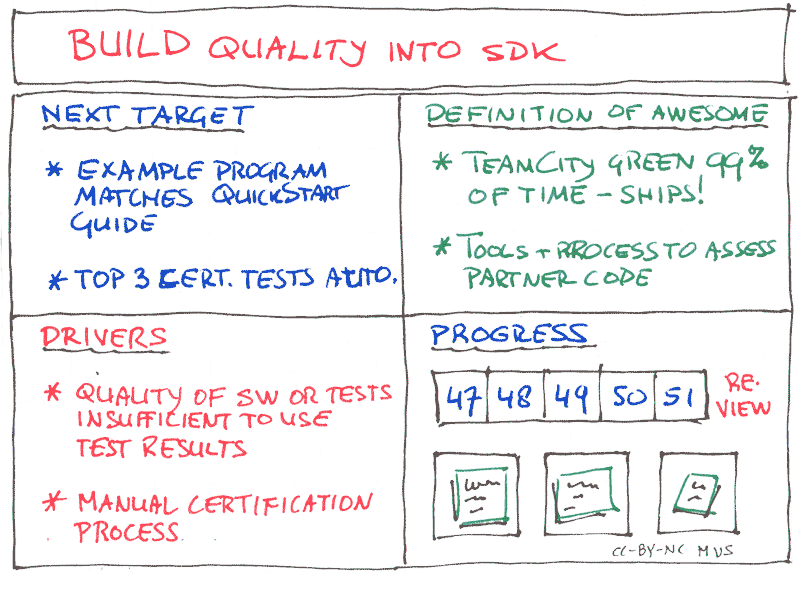Difference between revisions of "Improvement board"
(Zeroth version.) |
m (Improvement-board.png) |
||
| (2 intermediate revisions by the same user not shown) | |||
| Line 3: | Line 3: | ||
|stage=Sparkle | |stage=Sparkle | ||
|theme=Agile, Lean | |theme=Agile, Lean | ||
|image=Improvement- | |context=working with one or more teams on a {{p|big hairy audacious goal}}. | ||
|wish full=Ever getting better in getting better | |wish=Ever getting better in getting better requires a learning culture. | ||
|so=Use an information radiator to list and execute improvement kata towards the definition of awesome. | |||
|image=Improvement-board.png | |||
|wish full=Ever getting better in getting better requires a learning culture. | |||
|background={{author|Henrik Kniberg}} says that {{p|squads}} at {{organization|Spotify}} are using a {{p|big visible chart}} as {{p|improvement board}} that focuses on one to three {{p|actionable accelerators}} like: “What is blocking us?” | |background={{author|Henrik Kniberg}} says that {{p|squads}} at {{organization|Spotify}} are using a {{p|big visible chart}} as {{p|improvement board}} that focuses on one to three {{p|actionable accelerators}} like: “What is blocking us?” | ||
| Line 17: | Line 20: | ||
*My improved version is live in week two. | *My improved version is live in week two. | ||
Awesome is a direction, not a place, so it does not even have to be realistic. The | Awesome is a direction, not a place, so it does not even have to be realistic. The {{p|squads}} use a {{p|definition of awesome}} to help focus improvements and track progress. | ||
The {{p|improvement board}} is inspired by a technique called {{p|improvement kata}}, showing: | The {{p|improvement board}} is inspired by a technique called {{p|improvement kata}}, showing: | ||
| Line 24: | Line 27: | ||
#'''realistic next target condition''' that is one step closer to awesome; and | #'''realistic next target condition''' that is one step closer to awesome; and | ||
#'''next three steps''', actions that take you to the '''realistic next target condition'''; | #'''next three steps''', actions that take you to the '''realistic next target condition'''; | ||
#*when these get done, the | #*when these get done, the {{p|squads}} fills them up with new improvement actions; | ||
#*this section also shows a little week calendar. | #*this section also shows a little week calendar. | ||
|therefore full=Use an {{p|information radiator}} to list and execute {{p|improvement kata}}. Set its direction with a {{p|definition of awesome}}. Tackle tough problems with an {{p|a3 solver}}. Capture your learnings by gardening a {{p|pearl language}} and a set of {{p|excellence guide}}s. | |therefore full=Use an {{p|information radiator}} to list and execute {{p|improvement kata}}. Set its direction with a {{p|definition of awesome}}. Tackle tough problems with an {{p|a3 solver}}. Capture your learnings by gardening a {{p|pearl language}} and a set of {{p|excellence guide}}s. | ||
Latest revision as of 16:07, 25 November 2014
…working with one or more teams on a big hairy audacious goal.
✣ ✣ ✣
Ever getting better in getting better requires a learning culture.
Henrik Kniberg says that squads at Spotify are using a big visible chart as improvement board that focuses on one to three actionable accelerators like: “What is blocking us?”
Also, the board shows a definition of awesome that includes things like:
- Really finishing stuff.
- Easily ramping up new team members.
- No recurring tasks or bugs.
Beyond that, the definition of awesome architecture makes explicit:
- I can build, test, and ship my feature within a week; and
- I use data to learn from it; and
- My improved version is live in week two.
Awesome is a direction, not a place, so it does not even have to be realistic. The squads use a definition of awesome to help focus improvements and track progress.
The improvement board is inspired by a technique called improvement kata, showing:
- current situation;
- target situation in the form of a definition of awesome telling a little story about the perfect world;
- realistic next target condition that is one step closer to awesome; and
- next three steps, actions that take you to the realistic next target condition;
- when these get done, the squads fills them up with new improvement actions;
- this section also shows a little week calendar.
Therefore:
Use an information radiator to list and execute improvement kata. Set its direction with a definition of awesome. Tackle tough problems with an a3 solver. Capture your learnings by gardening a pearl language and a set of excellence guides.
✣ ✣ ✣
The improvement board is very similar to an a3 solver, a pattern or pearl, and the general beyond bullet points structure. The same structure is used in instant pay-off coaching to help someone get unstuck and grow.
✣ ✣ ✣
